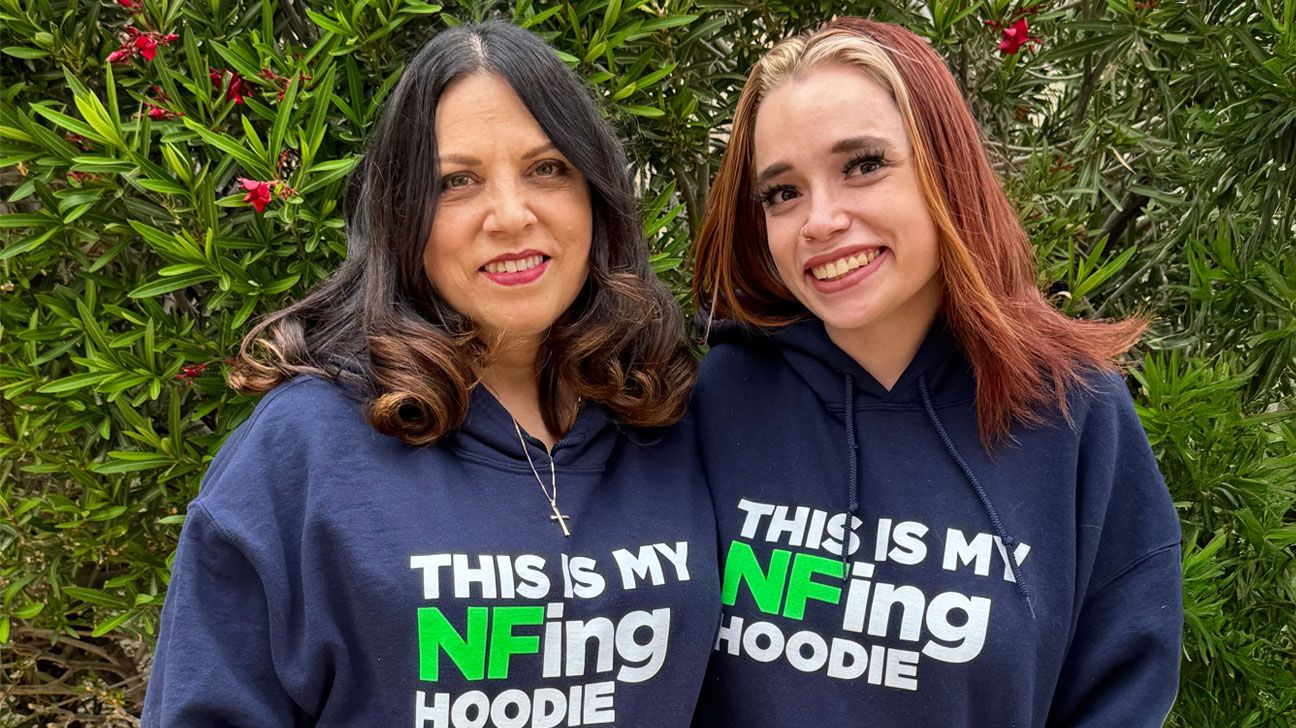Healthline News RSS Feed – Read More

- A mother and daughter share the same rare genetic disease that causes tumor growth throughout the body.
- After living with neurofibromatosis type 1 with plexiform neurofibromas (NF1-PN) for four years, daughter Samatha Pearson was accepted into a clinical trial that changed her life.
- The mother-daughter duo shares their journey of managing the condition and advocating for others living with the rare disorder.
In July 2015, Samantha Pearson was at summer camp playing a running game in the gym when her knee buckled, and she collapsed.
“The pain started immediately,” she told Healthline.
When she told her parents about the pain, they decided to wait and see if it would subside on its own. However, after a few days of constant pain, they took her to the doctor.
“After doing an X-ray of my knee cap, he showed mom the tumor in my femur and knee, and he said to go see an orthopedic surgeon,” said Samantha.
A couple of days later, at the orthopedic surgeon’s office, an X-ray of Samantha’s waist down revealed 27 tumors.
The doctor informed Samantha and her mom, Michelle, that she most likely had neurofibromatosis type 1 (NF1) with plexiform neurofibromas (PN), a chronic disease in which tumors grow along nerves and can cause severe pain, mobility issues, and disfigurement.
“He handed me a note with the condition written on it and told me to call Shriners Children in Salt Lake City because there was no one in Las Vegas who could treat her. I was terrified,” Michelle told Healthline.
A rare genetic disease
After waiting for several months, Samantha was able to get an appointment at Shriners Children’s Hospital in October 2015.
“The doctor took one look at Samantha and said, ‘You have neurofibromas’ and he looked at me and said, ‘She got it from you,’” said Michelle.
While NF1 is a genetic condition, as many as half of those diagnosed with NF1 might not have a family member with the condition, said Phioanh Leia Nghiemphu, MD, professor of clinical neurology at the University of California, Los Angeles, and clinical director of the UCLA Neurofibromatosis Program.
“Within one family, the manifestations of NF1 can also be different, so even if a family has many members with NF1, not all of them will have NF1-PN,” she told Healthline.
Like the Pearsons, people with NF1 might have PN developed since birth, but the PN might not be diagnosed until their late adolescence or adult age, Nghiemphu added.
Based on visual characteristics of the condition, including neurofibromas and freckling, the doctor determined that both Samantha and her mother have the same condition.
Michelle had experienced partial deafness in her left ear for about a decade, which she learned was due to a tumor near her ear.
“It was a shock. I had never heard the word neurofibromas before,” said Michelle. “I had no idea I had this. When the doctor told us about the visual characteristics, I asked my parents if it runs in the family and I checked out my two boys to see they had any symptoms.”
Her sons showed no signs and her parents knew of no one else in the family with the condition.
Michelle was relieved that her sons didn’t have the condition and that she didn’t experience debilitation or pain from it. However, it was difficult to witness Samantha’s suffering, she said.
“Because [the tumors] grow on nerves and can grow very large, they can cause disfiguration, pain, difficulty using various body organs because of compression, or numbness and paralysis,” said Nghiemphu.
Removing tumors by surgery can be painful, too, yet if they are not removed, they have a rare risk of developing into cancer called malignant peripheral nerve sheath tumor (MPNST), which is rare.
But in most cases, NF1 is not a deadly disease. Most people with the condition have an average life expectancy.
A life-changing clinical trial
Because Shriners does not provide emergent care, Samantha was referred to Primary Children’s Hospital in Salt Lake City to have the tumor in her left femur removed.
However, the doctor who was recommended to Michelle through a parents’ support group had a three-year waiting list.
“I didn’t care that he had a three-year waiting list. I wasn’t going to leave until Samantha saw him,” said Michelle. “I was unruly, outspoken, and unconventional cause I’ll do anything for my kid. I had no interest in keeping quiet. My daughter was not well.”
Her advocacy resulted in Samantha receiving care from the doctor, who suggested that Samantha participate in a clinical trial. After not qualifying for several trials, in 2019, she finally qualified for the Phase 2b ReNeu trial, which studied the medication Gomekli (mirdametinib).
Samantha took the first dose of medication in December 2020.
“The beginning of the trial was rough. I got a bad, painful acne rash, nausea, and vomiting was the worst part. I had no appetite, and I’d try to eat something and then immediately throw up,” said Samantha.
After about six months of participating in the trial, she was ready to give up until she received good news.
“My mom and dad were moving my brother to college and big things for the boys always turn into something about me and so I wanted to be respectful, so I asked mom if she had two minutes to walk away and hear good news,” said Samantha.
She shared that the doctors informed her that her tumor had shrunk by 82%. By the end of the trial, she had 90% shrinkage by volume and her pain was significantly reduced.
“Before the trial… even putting on a t-shirt or bra would hurt it. I’m a very physical touch person and love hugs; hugs would hurt. Coughing too hard would hurt, sneezing would hurt,” said Samantha.
The Food and Drug Administration (FDA) approved Gomekli in February 2025 for adults and children with NF1-PN. The approval was based on the trial Samatha participated in.
“A few years ago, surgery was the only option, which can lead to many complications, and up to approximately 85% of plexiform neurofibromas cannot be completely removed through surgery,” said Nghiemphu.
In addition to Gomekli, there is one other FDA-approved medication for the treatment of PN in pediatric patients with symptomatic, inoperable NF1-PN. However, it is not approved for adults.
“It is very recent that we finally have medical treatments for NF1-PN, but they are not perfect and do not work for everyone, and we hope that we can continue with research programs that help patients with these rare conditions so they can lead better lives,” Nghiemphu said.
Humor, advocacy helped them cope
While they were close before they learned they had NF1-PN, the condition brought Michelle and Samantha closer.
Michelle said humor helped strengthen their bond.
“I would mock her. I don’t mean that in a nasty way but I had to make her laugh. It kind of stinks. Why my kid? Why is this happening? We tried really hard to laugh at everything,” she said.
When Samantha complained about the pain in her plexiform, they nicknamed it plexi, referring to it in a silly, whiny voice.
“I’d say, ‘My plexi, you’re hurting me,’” said Samantha.
Then they’d laugh together.
While waiting at the hospital, she also relied on her mom’s humor to help pass the time. She recalled a time they waited in radiology for images and played the game Heads Up.
“We were shaking money makers and my dad said, ‘I’m not doing that, that’s all you.’ We wrestled, we stop drop and rolled,” said Samantha.
Michelle went all out.
“I know people were staring at us, but the fact of the matter is that everyone who was staring was wishing their mom was just as much of a lunatic as I am and that they were playing it too,” she said. “If I can keep one mom from feeling that fear because Samantha and I are making fun of each other, then awesome.”
They also share a passion for spreading awareness about NF1-PN by speaking and attending events with the Neurofibromatosis Network and the Children’s Tumor Foundation. Samantha has also advocated on Capitol Hill and continues to share her story to inspire others.
“I let [this disease] define me for a while, and I was told I was never going to dance again, and dance was my first passion and first love, and two years later, after my first surgery, I was back dancing on my high school dance team,” she said.
While it wasn’t easy, she also excelled academically in high school. Today, she is attending college and working toward becoming a certified nursing assistant as she aspires to eventually become a registered nurse.
“I want others to know that this does not have to define you,” she said.




